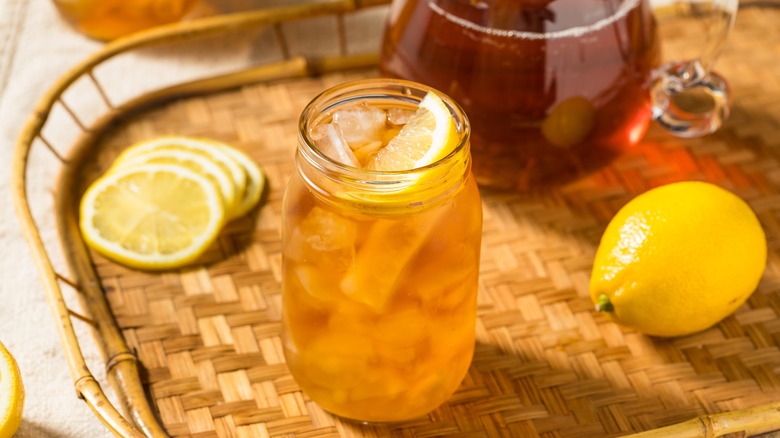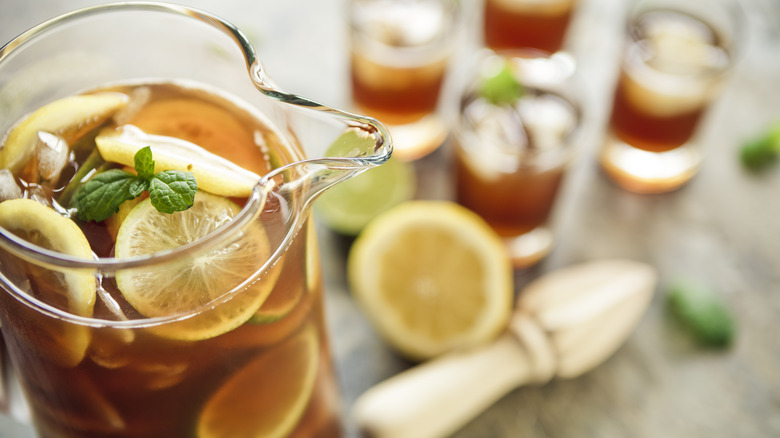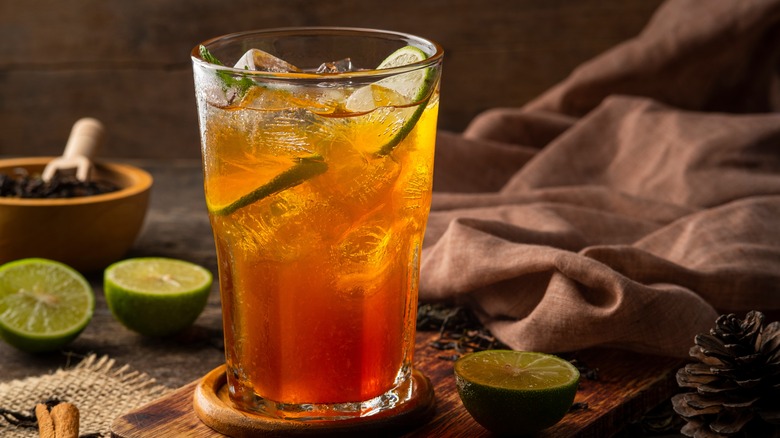How Sweet Tea Became A Southern Staple
Long before tea leaves were used to make a warm drink, they were used for medicinal purposes in China. But once people began to consume the drink for enjoyment, the practice spread throughout the world. Humankind has been drinking tea for well over 1,000 years now, and from the way people in the southern United States talk about sweet tea, you'd think they've been drinking it for that long, too. Of course, that's not really the case.
Tea arrived in the United States in the mid-1600s but it wasn't until the early 1800s when recipes specifically for cold, sweet tea were written down in books. This was right around the time commercial refrigeration was spreading throughout the country. A major reason that sweet tea took a firm hold in the American South is that growing tea leaves became a huge industry in South Carolina, giving the adjoining states convenient access to the crop. Folks also had good reason to drink a lot of the chilly beverage: The South got hot in the summertime; much hotter than most other regions in America. It's easy to understand why these citizens who worked under the hot sun quickly gained a passion for the drink. Then again, maybe it was the alcohol in it that they fell for.
Sweet tea was only for grownups at first
One early recipe for iced tea found in the 1839 cookbook "The Kentucky Housewife" by Lettice Bryan instructed readers to combine strong tea with plenty of sugar and sweet cream followed by a bottle of either claret wine or Champagne. This made the tea more appropriate for parties than it was for Sunday family dinners or sipping on the porch with the grandkids. At this time, it was imported green tea that was primarily used, which was expensive and, therefore, appropriate for soirees. Soon, larger quantities of black tea were brought to the U.S.; this, combined with the tea growing industry that was booming in South Carolina, meant that more families now had a cheaper tea alternative — one that could be shared around the tables of every class in society, not just the rich.
As refrigeration spread, so did iced tea, which could now be served not just cold, but with actual ice in it. In 1879, the first printed recipe for booze-free iced tea was published in a magazine called "Housekeeping in Old Virginia." It required green tea to be boiled and steeped for an entire day. Upon serving, sugar was to be added to iced glasses, followed by the tea and a slice of lemon. The South's fondness for sweet tea could be seen in the fact that southerners began serving it in special, tall glasses with long spoons.
How Prohibition impacted the popularity of sweet tea
The popularity of sweet tea in the South grew steadily into the 20th century, but would skyrocket with the coming of Prohibition in the 1920s. With booze outlawed, people sought out other drinks to quench their thirst, and iced tea made a mighty fine refresher during the summers in the South (whether or not those glasses were spiked with bootleg Prohibition-era whiskey, we can only guess).
Sweet tea's appeal hasn't waned in the South since then. It could rival the Brit's fondness for hot tea. It's truly a traditional drink, so much so that if you order an iced tea anywhere in the region, chances are it will come sweetened. So, if you want yours sans sugar, you'll have to request it. Of course, that will immediately give you away as an out-of-towner, but Southern hospitality will still shine (as a new resident of the deep South, I can attest that it really does exist).
You never know how sweet your tea will be down South. It tends to range from barely-there to toothache-triggering. But on a 95-degree day in July with 85% humidity, all that matters is that ice-cold temperature.


